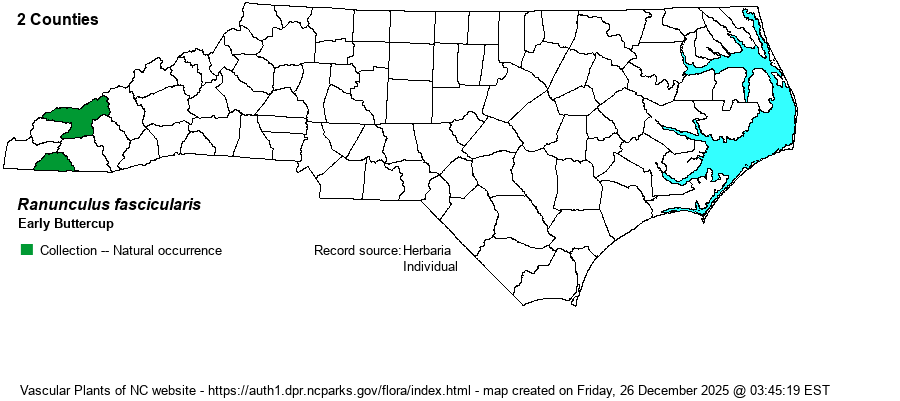| Author | Muhlenberg ex Bigelow | |
| Distribution | Strictly in the far southwestern Mountains. Specimens from Clay and Swain counties are accepted for this website. Specimens for Jackson, Polk, and Anson counties in SERNEC are not considered as correctly identified. Certainly present without question at the Buck Creek Barrens in Clay County.
This is a very widespread species of the Midwest/Great Plains, from MI and MN south to LA and eastern TX. However, very widely scattered eastward, mainly to New England and central VA. | |
| Abundance | Very rare and highly localized (in rare habitats) in the southwestern Mountains. This is a State Signficantly Rare species, as tracked by the NCNHP. | |
| Habitat | This species favors high pH soils in dry and often rocky conditions. It is found in serpentine barrens, or limestone or dolomite glades (at least in other states), and other open and dry woods on circumneutral soil. | |
| Phenology | Blooms quite early, starting in late winter, from February to May; fruits about a month after flowering. | |
| Identification | This species is similar to the common and widespread R. hispidus, which can be quite variable. R. fascicularis has mostly basal leaves, which are longer than wide. These are very narrowly divided into numerous, slender segments or lobes, the terminal segment stalked (narrowed at the base). The few stem leaves are smaller, and the flowering stems can grow to about 1 foot high. Terminating each of the several flowering stems is a solitary flower, with 5 glossy and bright yellow petals (and slightly smaller sepals), reaching about 3/4-inch across in full bloom. R. hispidus has the larger leaves generally wider than (or equally as wide as) long, and these leaves tend to be palmately divided into 3 segments, rather than pinnately divided into 3-7 segments. These segments in R. fascicularis are quite narrow, as opposed to fairly wide in R. hispidus. These leaf characters also separate R. septentrionalis from R. fascicularis, and that species grows in wet woods and marshy places, not in dry, high pH soils. | |
| Taxonomic Comments | Though essentially all recent references consider this as a valid species, some older references, including RAB (1968), included it erroneously within R. hispidus.
| |
| Other Common Name(s) | Thickroot Buttercup, Tufted Buttercup, Prairie Buttercup | |
| State Rank | S1 | |
| Global Rank | G5 | |
| State Status | SR-P | |
| US Status | | |
| USACE-agcp | FAC link |
| USACE-emp | FACU link |

